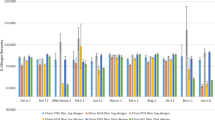Abstract
Objectives: To clarify whether the intensity of exposure to organic acid anhydrides (OAAs) is associated with the risk of sensitisation to these allergens. Methods: The investigations were carried out in three different manufacturing plants (A, B, and C) where OAAs were used in the production of epoxy resins. Methyltetrahydrophthalic acid anhydride (MTHPA) was used in all three plants. The exposure assessment included stationary and ambient air monitoring (OAAs in the air) and biological monitoring (metabolites in urine). In plant A 20, in plant B 86 and in plant C 113 employees were examined by a physician (anamnesis, skin-prick test, specific IgE, spirometry). In plants B and C, the exposure areas were classified as high, medium, and low, without the results of the exposure assessment being known. Results: The ambient air concentrations (in μg/m3) of MTHPA were 37.2 and 58.5 in plant A (number of samples n=2), ranged from <0.5–26.2 in plant B (n=5) and from 2.1–57.9 in plant C (n=3) with stationary air collecting, and from 8–45 (n=6), from <4.7–35.7 (n=3) and from 2–37.8 (n=3) with personal air collection. The metabolites of OAAs in urine (in nmol/mmol creatinine) ranged from 5.7–645 (median of MTHPA: 346) in plant A, from <1–213 (median of MTHPA: 10.1) in plant B and from 0.1–830 (median of the sum of the OOA metabolites: 108.6) in plant C. The prevalence of sensitisation was 35% in plant A, 21% in plant B and 29% in plant C. A higher prevalence in the highly exposed areas, however, could not be seen. Levels of IgE specific for conjugates of MTHPA were not associated with the metabolites in the end of shift urine. Levels of IgG specific for conjugates of MTHPA, however, were associated with the metabolites in the end of shift urine. Conclusions: The data showed that biological monitoring is a useful tool in the exposure assessment of OAAs. Comparing the prevalence of sensitisation and the results of biological monitoring, between the three plants, we found that sensitisation increased with increasing exposure. Within a plant a higher risk of sensitisation in persons working in highly exposed areas at the time of the examination could not be seen, possibly due to frequent job rotation.
Similar content being viewed by others
Author information
Authors and Affiliations
Additional information
Received: 2 August 1999 / Accepted: 29 January 2000
Rights and permissions
About this article
Cite this article
Drexler, H., Jönsson, B., Göen, T. et al. Exposure assessment and sensitisation in workers exposed to organic acid anhydrides. Int Arch Occup Environ Health 73, 228–234 (2000). https://doi.org/10.1007/s004200050422
Issue Date:
DOI: https://doi.org/10.1007/s004200050422




